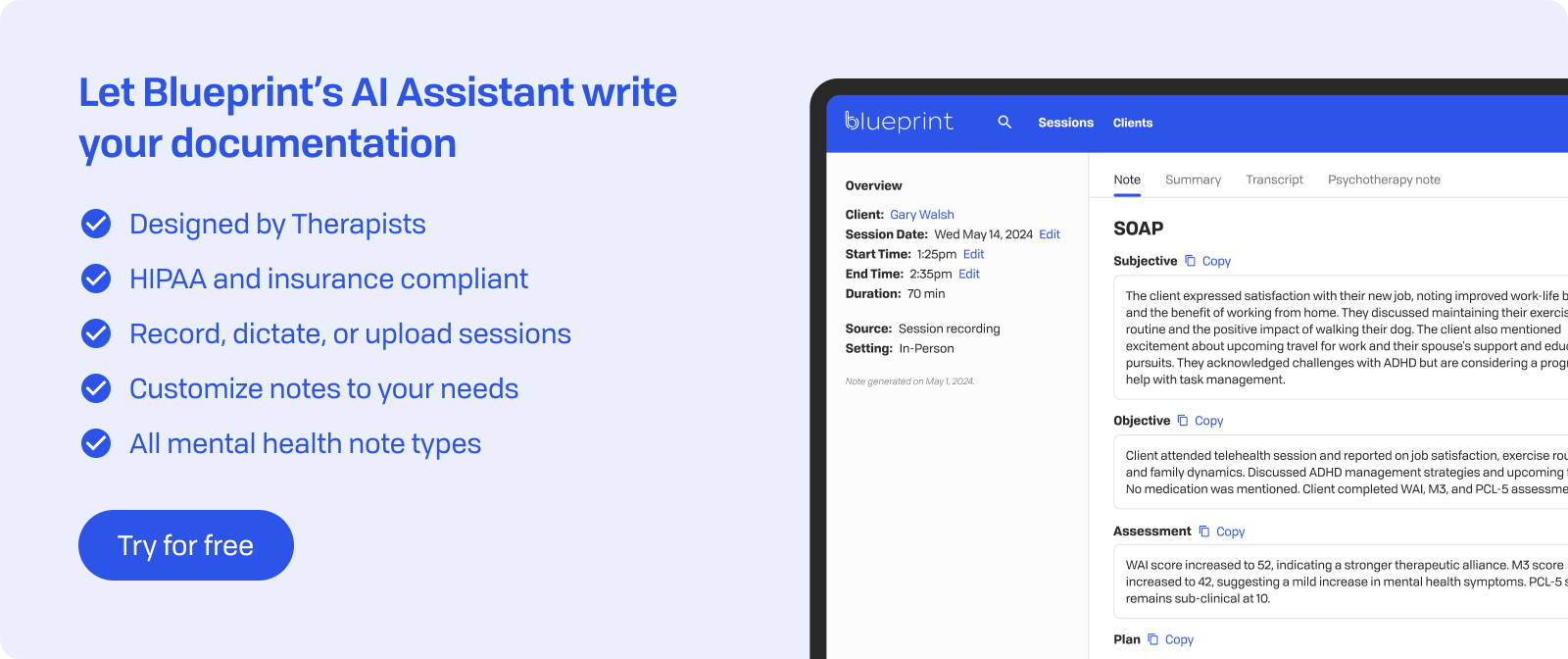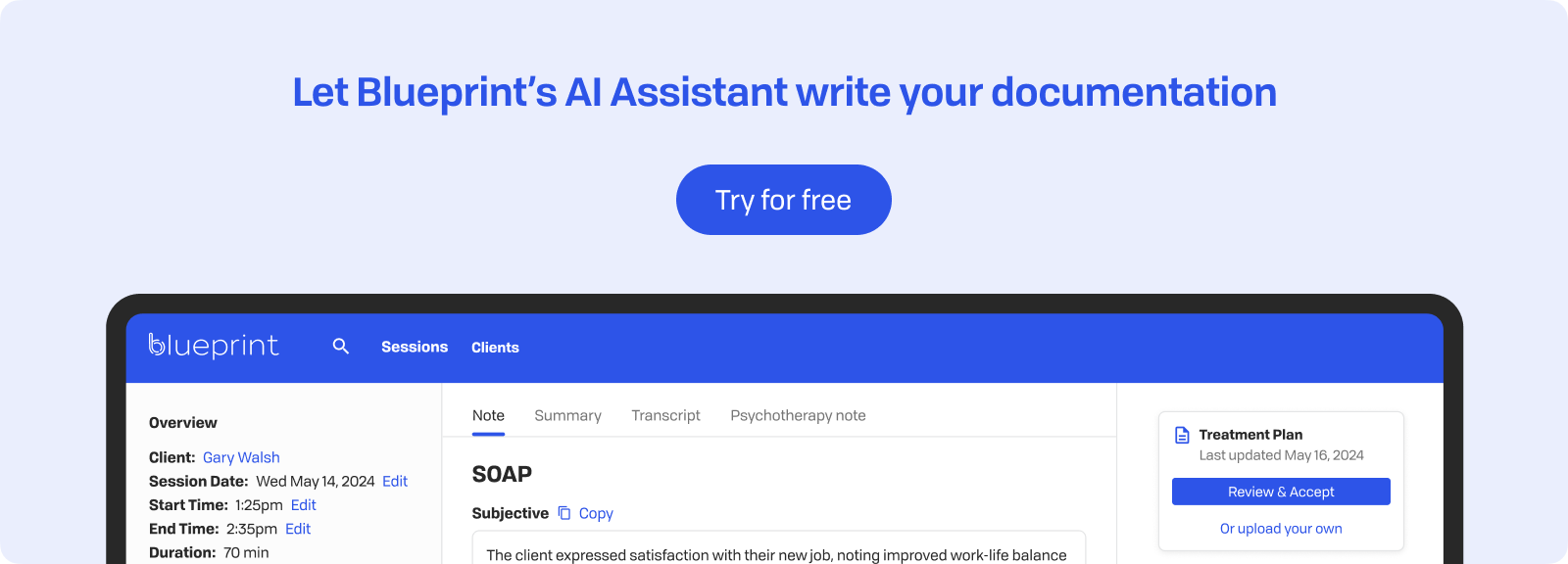
In Brief
The administrative workload for therapists has reached a tipping point. Many clinicians spend hours after their last client leaves, typing notes and trying to remember session details. This time spent on documentation cuts into personal life, leads to burnout, and often results in less accurate records.
There's a documentation method gaining traction that could change how you handle your session notes. It challenges the traditional note-taking model most of us learned in graduate school. While it might feel awkward at first, many therapists find it improves their practice efficiency.
This change in documentation practice addresses multiple issues at once. It can reduce after-hours work, improve note accuracy, and even enhance the therapeutic process itself. Let's look at what this approach involves and whether it might suit your practice.
Understanding Concurrent Documentation
Concurrent documentation means writing your session notes during the therapy appointment rather than afterward. Instead of relying on memory to recall conversations hours or days later, you capture information in real-time. This approach marks a significant shift from the traditional documentation methods most therapists learned during training.
The most common format for concurrent clinical documentation involves typing notes on a laptop or tablet while the client speaks. Some therapists type continuously throughout the session, while others pause at natural breaks to summarize key points. Another popular method is dedicating the final 5-10 minutes of each session to collaborative note-writing with the client present.
Traditional note-taking typically occurs after the client leaves, often at day's end. Therapists depend on memory, jotted keywords, or brief shorthand to reconstruct session content. Concurrent documentation removes this memory-dependent step by capturing information as it unfolds.
Interest in concurrent documentation is growing due to various factors. Therapist burnout has reached high levels, with documentation workload noted as a major cause. Electronic health record systems provide a natural way for therapists to use concurrent documentation as opposed to writing notes with pen and paper. The pressure from payors to see more clients while maintaining quality documentation has made traditional after-session note-taking unsustainable for many practices.

Clinical and Administrative Benefits
Switching to concurrent documentation shows noticeable improvements in both clinical and administrative areas, addressing issues that often lead to therapist burnout and practice inefficiencies.
- Cuts down on after-hours paperwork and clinician fatigue: Writing notes during sessions removes the need for late-night documentation marathons. Therapists often leave work with completed notes, reclaiming personal time and easing the mental burden of unfinished tasks.
- Improves note accuracy while the material is fresh: Documenting in real-time captures exact quotes, specific interventions, and client responses as they happen. This approach prevents the memory fade that occurs when notes are written later, leading to more detailed and useful records.
- Ensures compliance with insurance and timely documentation requirements: Many insurance companies require notes within 24-48 hours of service. Concurrent documentation naturally meets these deadlines, reducing claim denials and payment delays, and also satisfies regulatory requirements for timely record-keeping.
- Supports billing compliance and audit readiness: Complete, contemporaneous notes provide stronger justification for billing. During audits, real-time notes clearly show medical necessity and appropriate service delivery. The thoroughness of concurrent documentation often surpasses audit requirements, protecting practices from recoupment demands.
These administrative improvements directly enhance clinical care. Therapists with less documentation stress report higher job satisfaction and more mental energy for engaging with clients. The accuracy of real-time notes also aids in better treatment planning and clearer progress tracking over time.
Client Experience and Ethical Considerations
Switching to concurrent documentation requires careful consideration of its impact on the therapeutic relationship. Many therapists worry about maintaining eye contact and emotional connection while typing. These concerns are valid, and discussing them openly with clients helps build trust around this practice.
Being upfront is crucial for ethical concurrent documentation. During intake or the first session, explain that you'll be taking notes during sessions to ensure accuracy and better track progress. Use simple language: ""I want you to know that I’ll be taking some notes during our sessions. This helps me keep track of what we talk about and makes sure I’m accurate in documenting your care. If at any point the typing feels distracting or you’d prefer a pause, please let me know. My goal is to stay present with you while also keeping thorough records so we can see your progress over time.""
Consider these approaches for maintaining therapeutic rapport:
- Strategic typing moments: Type during natural pauses or when clients are reflecting, keeping eye contact during emotionally charged moments.
- Collaborative review: Invite clients to review notes at session end, asking "Did I capture that correctly?" or "What would you add?"
- Shared screen option: For teletherapy, consider sharing your screen while typing to make the process completely transparent.
- Client choice: Always respect preferences—some clients may feel uncomfortable with real-time documentation.
Client comfort and confidentiality remain paramount. Ensure secure storage of electronic records. Some clients find concurrent documentation reassuring, knowing their words are captured accurately rather than filtered through memory. Others may need time to adjust or may prefer traditional documentation methods.
The key lies in understanding each client's comfort level and adapting accordingly. This flexibility shows respect for individual preferences while maintaining professional standards.

Practical Implementation in Private Practice or Agencies
Making concurrent documentation work requires careful planning and the right technological setup. Whether you're in solo practice or part of a larger agency, these strategies help create sustainable documentation habits.
Workflow optimization strategies:
- Note templates: Develop customizable templates with common session elements pre-filled. Include sections for presenting concerns, interventions used, and client responses to speed up documentation.
- EMR shortcuts: Learn keyboard shortcuts, text expanders, and quick phrases. Set up macros for frequently used clinical terms and intervention descriptions.
- Split-screen setup: Use dual monitors or split-screen views to keep client information visible while documenting. This reduces clicking between windows and maintains session flow.
Selecting supportive technology: Choose EHR systems with features like customizable therapy templates, voice dictation capabilities, and mobile-friendly interfaces. Important features include HIPAA-compliant security, integrated scheduling, and billing functions that work seamlessly with live documentation.
Collaborative session structure: Reserve the final 5-10 minutes for collaborative review. Use prompts like "Let me summarize what we discussed today" to naturally transition into documentation time. This approach validates client experiences while ensuring accurate records. Some therapists find success with mid-session check-ins, pausing to document key insights before moving to new topics.

Best Practices for Therapist Success
Developing skills for concurrent documentation helps you maintain a therapeutic presence while recording important information. These practices keep you engaged with clients and ensure you create accurate, useful records.
Use concurrent summaries for session wrap-up: Dedicate the last 5-10 minutes to reviewing notes with your client. You might say, "Let me share what I captured from our conversation today." This collaborative approach validates their experience, ensures accuracy, and provides a natural closure. Clients often add important details or corrections during this review.
Avoid documentation during emotionally intense moments: When clients share trauma, cry, or experience breakthroughs, pause your typing and put your device to the side if in-person. Your full presence matters more than perfect documentation. Make a brief mental note or jot a single keyword to revisit later. You can always add details during your post-session review time.
Practice active listening while typing: This skill develops over time. Focus on:
- Maintaining eye contact during pauses in typing
- Using verbal acknowledgments ("I hear you," "That sounds difficult") while documenting
- Developing muscle memory for common phrases to reduce cognitive load
- Typing only key points rather than attempting verbatim transcription
Time-block for review and corrections: Schedule 5-10 minutes after each session for note refinement. This buffer allows you to add clinical impressions, correct errors, and ensure notes meet documentation standards. Even with concurrent documentation, this review time catches details you might have missed while maintaining therapeutic engagement.
The aim is not perfection but finding a sustainable balance between thorough documentation and meaningful client connection.
Common Challenges and How to Address Them
Even with the best intentions, implementing concurrent documentation presents some hurdles. Knowing these challenges and having strategies ready can help make the transition smoother.
Client discomfort or feeling unheard: Some clients might see typing as a sign of distraction or disinterest. Address this directly by saying, "I notice you seem uncomfortable with my note-taking. Would you prefer I wait until the end?" Many clients actually feel validated when their words are documented in real-time. For those who remain uncomfortable, consider taking minimal notes during the session and completing them immediately afterward.
Technology barriers: Slow systems can disrupt the session flow and create frustration. Consider these solutions:
- Offline-capable software that syncs when the connection improves
- Keyboard shortcuts to reduce clicking and waiting
- Backup methods like paper notes when systems fail
- Strategic screen positioning to maintain eye contact while typing
Therapist resistance or adjustment period: The change may feel awkward initially. Most therapists report needing to use concurrent documentation for a while before they feel comfortable with it. Start with one client daily, gradually increasing as confidence builds. Practice typing common phrases during non-clinical time to build muscle memory.
Dealing with productivity guilt or perfectionism: Many therapists struggle with the idea of "good enough" documentation. Keep in mind that concurrent notes capture more accurate information than memory-based documentation, even if they feel less polished. Set realistic standards—aim for clinically sufficient notes, not literary masterpieces. Use post-session review time for refinement rather than complete rewrites.
The adjustment period is temporary, but the reduced documentation burden and improved accuracy are lasting benefits.

When to Avoid Concurrent Documentation
While concurrent documentation offers many benefits, certain clinical situations require your full attention. Being aware of these moments protects the therapeutic relationship and ensures ethical practice.
Crisis sessions, trauma disclosures, or intense emotional processing: When clients face crises or share traumatic experiences, they need your complete presence. The sound of typing might feel dismissive or cause feelings of being "reported on" rather than truly heard. During these moments, put away the laptop completely. Saying, "I'm going to focus completely on you right now," acknowledges the importance of what they're sharing.
New clients with trust concerns: Building rapport is more important than documentation efficiency in early sessions. Some clients need several sessions to feel comfortable with any note-taking. Look for signs of discomfort—like shifting away from the screen, giving brief responses, or asking direct questions about what you're writing. Consider traditional documentation for the first few sessions until trust develops.
Clients with attention or paranoia issues: For clients with ADHD, the clicking of keys can disrupt their thought process. Those experiencing paranoia might see typing as evidence of surveillance or reporting to authorities. These clients often benefit from seeing handwritten notes or having no visible documentation during sessions.
Cases where cultural sensitivity suggests the need for more eye contact: Many cultures see direct eye contact as essential for respect and connection. Some clients may view looking at a screen as disinterest or rudeness. Ask about cultural preferences during intake and adjust accordingly.
Key Takeaways
Concurrent documentation changes how therapists approach session notes, bringing both opportunities and responsibilities that need careful consideration.
Administrative and accuracy benefits are substantial: Writing notes in real-time bridges the gap between sessions and documentation, capturing exact quotes and interactions. This method significantly cuts down on after-hours paperwork, allowing therapists more personal time while keeping records more accurate and detailed for better treatment planning.
Ethical implementation is a must: Transparency is key to successful concurrent documentation. Always discuss your documentation approach during intake, get clear consent, and be flexible with client preferences. While some clients appreciate real-time note-taking, others may prefer traditional methods—respecting these differences maintains trust in therapy.
Success relies on three pillars:
- Technology setup: Efficient EHR systems, customizable templates, and keyboard shortcuts
- Workflow habits: Intentional typing moments, collaborative review time, and post-session refinement periods
- Self-awareness: Knowing when to pause typing during emotional moments or with certain client populations
One size doesn't fit all: Concurrent documentation may not suit crisis situations, new clients with trust issues, or those with attention challenges. Cultural considerations around eye contact and engagement also influence when to use this method.
Gradual implementation can help make the process more effective: Begin with one willing client each day, building comfort over 4-6 weeks. Regularly reflecting on what works—and what doesn’t—helps create a sustainable practice that benefits both therapist wellbeing and client care. The aim isn’t perfection but finding a balance that reduces burnout while maintaining a strong therapeutic presence.

How Blueprint can help streamline your workflow
Blueprint is a HIPAA-compliant AI Assistant built with therapists, for the way therapists work. Trusted by over 50,000 clinicians, Blueprint automates progress notes, drafts smart treatment plans, and surfaces actionable insights before, during, and after every client session. That means saving about 5-10 hours each week — so you have more time to focus on what matters most to you.
Try your first five sessions of Blueprint for free. No credit card required, with a 60-day money-back guarantee.























